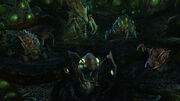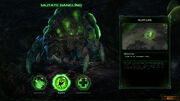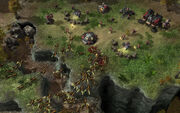
The evolution pit
The evolution pit[1] aboard Sarah Kerrigan's leviathan is controlled by Abathur, the evolution master.
Mutations

Selecting a baneling upgrade
The player can select one of three mutations for each unit to use. The player can switch mutations between missions.
- Adrenal Overload: +50% attack speed.
- Hardened Carapace: Gain an additional 10 hp.
- Metabolic Boost: +60% movement speed.
- Corrosive Acid: Increase damage to primary target by 100%
- Regenerative Acid: Explosion heals nearby friendly units and structures.
- Rupture: Increase splash damage area by 50%.
- Adaptive Plating: Gain +3 armor when life falls below 50%
- Hydriodic Bile: Gain +8 damage vs. light units.
- Tunneling Claws: Move at full speed when burrowed, and gain 100% life regen rate.
- Ancillary Carapace: Gain +20 HP.
- Frenzy: Gain +50% attack speed for 15 seconds, with 30 second cooldown.
- Grooved Spines: Gain +1 attack range.[1]
- Vicious Glave: Attacks deal increased damage and travel further, bouncing three more times for up to six targets.
- Rapid Regeneration: Regenerates 10 life per second while out of combat after a minimum of 5 seconds.
- Sundering Glave: Gains +9 damage vs. armored targets (an increase of 100%), but attacks no longer bounce to additional targets.
- Burrow: Swarm Hosts can now burrow into the ground, preventing them from being seen by enemies without detection while still being able to spawn Locusts.
- Rapid Incubation: Locusts spawn 20% faster.
- Pressurized Glands: Locusts can attack both ground and air units.
- Burrow Charge: Ultralisk burrows and charges toward a unit; when it erupts from the ground, all nearby enemy units are knocked back and stunned for 2 seconds.
- Tissue Assimilation: Gain life equal to 40% of all damage dealt from normal attacks.
- Monarch Blades: Gains +20 splash damage (an increase of 400%), dealing equal damage to both primary and secondary targets now.
Evolution

Selecting baneling evolution forms
Each unit features a final, irreversible choice. For instance, the zergling can become a raptor (which gains combat bonuses) or a swarmling (which spawn in greater numbers).[2]
Abathur inserts DNA sequences into the breed's genome for each mutation, but they fit into the same place.[3]
Evolutions are acquired in one of 14 short skirmishes far from the standard missions. This allows the player to play two mini-missions where native critters are harvested, concluding with a unit demonstration where the newly-evolved units attack a small enemy force.[1]
Zergling Evolution
Zergling: after either Fire in the Sky or Shoot the Messenger
- Raptor strain: Gains the ability to jump up and down cliffs, leap over obstacles and onto targets from range, and gains +2 damage (40% increase).
- Swarmling strain: Spawn 3 zerglings per egg, and their spawn speed near instant (2 seconds).

Raptors, upgraded zerglings, being field tested.
The raptor strain was developed on Calus, where a jumping strain of the karak was collected. The raptor strain subsequently destroyed a Dominion security outpost located on a cliff.
On Astrid III, swarmlings were developed from a feral zerg brood. They were then used to destroy a local Dominion garrison.[4]
Baneling Evolution
Baneling: after Old Soldiers
- Splitter strain: Banelings split into smaller baneling spawns upon detonation, each baneling spawn does 5 damage.
- Hunter strain: Banelings gain the ability to jump up and down cliffs as well as leap toward opponents.
The splitter was developed on Nelyth, home to the mitoscarab, a creature with a decentralized nervous system that could split into two upon death. To harvest the appropriate sequences, the mitoscarab prime was killed. The banelings were morphed into splitters, which were then used to destroy the Protoss forces on the planet.
On volcanic Scoria, banelings were subjected to lava tides, eventually resulting in some developing jumping abilities. These hunters were then used to attack a Terran Dominion mining camp.[5]
Roach Evolution
Roach: after Enemy Within
- Corpser strain: Units attacked by roach will spawn roachlings if killed.
- Vile strain: Roach attacks slow enemy movement and attack speed substantially.
The corpser strain was developed on Cantar, a hidden protoss world, from a strain of scantipede which housed a virulent parasite.
The vile strain was developed on the protoss-occupied world of Mehlus IV from roaches which were forced to drink microbe-infested water. The survivors became the vile roaches.
Both strains were successfully tested in combat against the local protoss forces.[6]
Hydralisk Evolution
- Impaler strain: Hydralisks can morph into impalers. Impalers have a long ranged anti-armor attack. Impalers must burrow to attack.
- Lurker strain: Hydralisks can morph into lurkers. Lurkers have an anti-light linear area of effect attack. Lurkers must burrow to attack.
The impaler strain of hydralisk were developed on Marek V, which housed Prometheus Company, a Terran Dominion infestation specialist unit. There, Ryloth's Brood was in danger of being wiped out. There were feral impaler colonies nearby (ancestors to the sunken colony) whose essence was used to develop the impaler morph. The impalers were then used to destroy Prometheus Company's base.
The lurker was redeveloped on Cavir, a former birthing colony for Daggoth. Kerrigan telepathically seized control of some feral lurkers but was unable to morph additional ones. Abathur determined that the key transformation sequence was missing, and a lurker den was needed. Kerrigan's lurkers found a den soon enough and defended it from the nearby feral zerg until Broodmother Kilysa arrived and reclaimed the den for the Swarm.[7]
Mutalisk Evolution
Mutalisk: after Hand of Darkness
- Brood lord strain: Can morph into a brood lord, which besieges ground targets from long range with spawned broodlings.
- Viper strain: Can morph into a viper, which can pull distant units close, slow enemy ground units and prevent them from attacking for several seconds, or drain life from allied units to restore its own energy. Also enables air-to-air combat.
The brood lord strain was re-inducted into the Swarm after the Swarm's mutalisks killed some feral brood lords and assimilated their essence. The mutalisks were then morphed into new brood lords which Kerrigan then sent to destroy the nearby Dominion defense platform Sigma Centari.
The viper strain was developed from primal zerg essence. Several vipers were used to steal jorium crystals from the Dominion on Brokas Hur.[8]
Swarm Host Evolution
Swarm host: after Conviction
- Carrion strain: Spawns flying locusts that can attack ground targets. Flying locusts are faster and deal 50% more damage than regular locusts, but have 25% less life.
- Creeper strain: Swarm host generates creep while burrowed or rooted. Enables Deep Tunnel ability to quickly travel to any location with creep.
The carrion strain developed on Cruxas III, in the city of New Babylon. Kilysa and her brood assisted Abathur in his mission. The carrion strain was developed after killing some native insectoids. The new strain was then used to destroy the Dominion's nuclear silos.[9]
The creeper strain developed on Ignus, where the local broodmother had been killed and the Ignus Brood was being attacked by the local burrowing ash worm. The swarm hosts destroyed the ash worm. Afterward, they transformed into creepers, and used their Deep Tunnel ability to defend the hive clusters from an invading Dominion force.[9]
Ultralisk Evolution
Ultralisk: after Planetfall
- Noxious strain: Emits Noxious Cloud that deals 5 damage per second to nearby enemy ground units. Toxic Blast ability deals 20 damage to enemy ground units and structures.
- Torrasque strain: When killed, enters a chrysalis for a short period before resurrecting with full health. Rebirth cooldown is 60 seconds.
The noxious strain was developed at the Metis research facility, overseen by Dr. Klein, near Augustgrad. The evolution was an accidental evolution due to gas tanks meant to kill the ultralisks breaking open and the gas subsequently being incorporated into the ultralisk.
The torrasque strain was also redeveloped when ultralisks were exposed to experimental nukes, whose radioactive compounds were integrated into the atrophied strain and allow the ultralisks to reincarnate independently without the power of cerebrates. The new torrasque ultralisks were then used to destroy the Dominion's experimental nuclear weapons facility.[10]

|
Development
The following section contains information from a previous version of Evolution pit/Development which is no longer valid.
|
References
|
